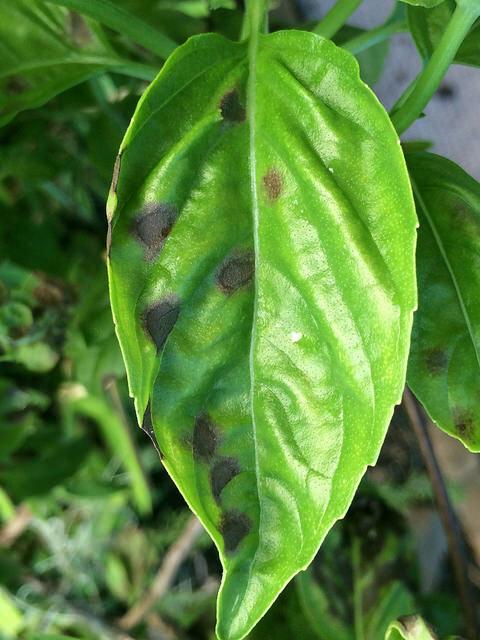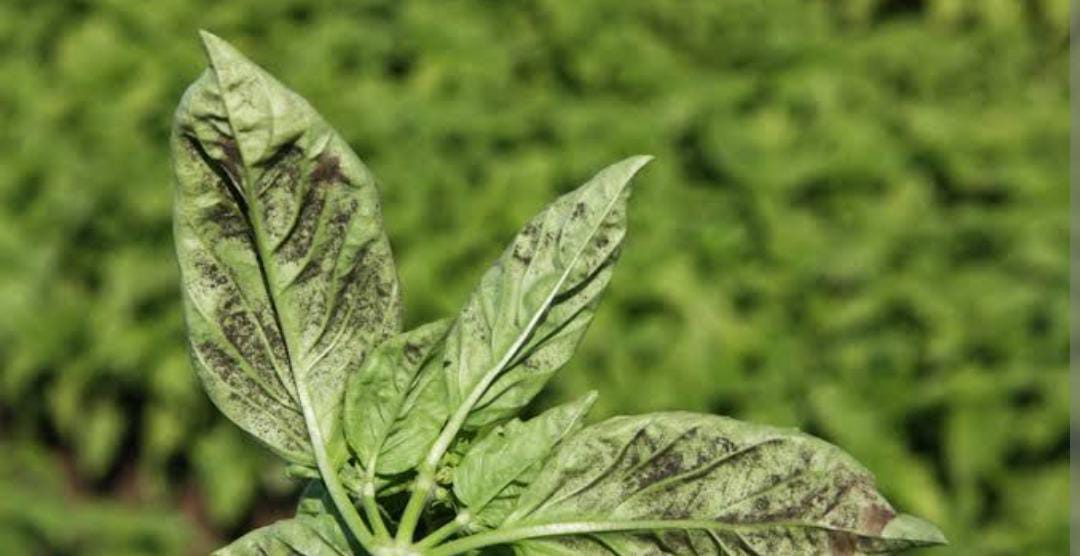Basil Plant
Basil is an annual, 12-24 inches tall

Habit
Annual
Height
0.3-0.6 m
Growth
Fast
Soil
Moist-Well Drained
Shade
Partial shade to Full Sun
Moisture
Moist
Edible
Yes
Medicinal
Well-drained loamy soil
Origin
India
Climatic Condition
Tropical
Temperature (°)
20-30°C
Humidity (%)
50-60%
Potting media
Garden soil
Fertilizers
Balanced NPK
Watering
Regular watering; keep soil moist but not waterlogged
Plant Weight
0.2-0.5 kg
Flowering Time
Summer
Soil Ph level
6.0 - 7.5
Water Ph level
6.0 - 7.0
Soil EC
Medium
Yield Per Plant
0.25 to 1 lbs of basil per plant
NPK ratio
8:08:08
life Span
Annual
Health Benefits
Rich in antioxidants; supports digestive health.
Suggested Grow Media or Potting Mix ?
50% compost, 30% peat moss, 20% perlite
Suggested Fertigation/Fertilizers
Fertilize every 2 weeks with a balanced, water-soluble fertilizer.
Common Diseases and Remedies
Cercospora leaf spot ,Downy mildew
Circular to irregular dark spots on leaves with light centers. Gray fuzzy or downy growth on lower surface of the leaves; brown to black angular necrotic patches on the plant.
remove and destroy any symptomatic leaves, avoid wetting foliage. treat seeds with hot water to kill fungi prior to planting
HEALTH BENEFITS
Basil is a nutrient-rich herb with several health benefits, including:
1. Anti-Inflammatory & Antioxidant Properties
- Contains flavonoids and essential oils like eugenol, which help reduce inflammation.
- Protects cells from oxidative stress and aging.
2. Supports Heart Health
- Helps lower blood pressure and cholesterol levels.
- Contains magnesium, which improves blood flow.
3. Aids Digestion
- Stimulates digestion and reduces bloating.
- Has antibacterial properties that promote gut health.
4. Boosts Immunity
- Rich in vitamin C, vitamin A, and antibacterial compounds.
- Supports the body’s defense against infections.
5. Helps Manage Stress & Anxiety
- Adaptogenic properties help the body cope with stress.
- Tulsi (holy basil) is especially known for reducing cortisol levels.
6. Supports Skin & Hair Health
- Fights acne due to its antibacterial effects.
- Strengthens hair and reduces dandruff when used in oil or masks.
7. Regulates Blood Sugar
- May help control blood sugar levels, beneficial for diabetics.
What Is Basil?
Basil is a popular culinary herb known for its aromatic leaves. It belongs to the genus Ocimum and is used in various cuisines worldwide, particularly in Italian, Thai, and Mediterranean dishes. There are several varieties of basil, including sweet basil, Thai basil, and holy basil, each with its own distinct flavor and aroma.
What Are The Different Types of Basil
1. Sweet Basil (Ocimum basilicum):
This is the most common type of basil used in Italian cuisine. It has a sweet, slightly spicy flavor and is often used in pasta dishes, salads, and pesto sauce.
2. Thai Basil (Ocimum basilicum var. thyrsiflora):
Thai basil has a distinct licorice flavor with hints of anise. It is commonly used in Thai, Vietnamese, and other Southeast Asian cuisines, particularly in stir-fries, curries, and noodle dishes.
3. Holy Basil (Ocimum tenuiflorum):
Also known as Tulsi, holy basil is revered in Hindu culture for its medicinal properties. It has a spicy, peppery flavor and is often used in herbal teas and Ayurvedic remedies.
4. Lemon Basil (Ocimum basilicum var. citriodorum):
As the name suggests, lemon basil has a citrusy aroma and flavor reminiscent of lemon. It is often used in salads, seafood dishes, and infused oils.
5. Purple Basil (Ocimum basilicum var. purpurascens):
This variety of basil has purple-tinged leaves and a slightly spicy flavor. It is mainly used for decorative purposes in salads, garnishes, and as a colorful addition to dishes.
Location
Basil plants thrive in warm, sunny locations with well-drained soil. Here are some tips for the best location to plant basil:
1. Sunlight: Basil loves sunlight, so choose a spot in your garden or on your balcony that receives at least 6-8 hours of direct sunlight per day.
2. Temperature: Basil prefers warm temperatures, ideally between 70-90°F (21-32°C). Avoid planting basil outdoors until the threat of frost has passed in spring, as it is sensitive to cold temperatures.
3. Soil: Plant basil in well-draining soil that is rich in organic matter. Avoid heavy clay soils that may retain too much water and cause root rot. If planting in containers, use a high-quality potting mix with good drainage.
Sun light
Basil plants thrive in full sunlight and typically require at least 6-8 hours of direct sunlight per day to grow vigorously and produce abundant leaves. However, they can tolerate partial shade, especially in hot climates where some protection from intense afternoon sun can be beneficial. If you're growing basil indoors, place it near a south-facing window where it can receive plenty of sunlight throughout the day.
Soil
Basil plants prefer well-draining soil that is rich in organic matter. A loamy soil with good drainage is ideal for basil cultivation. Avoid heavy clay soils that may retain too much water, leading to root rot. Additionally, adding compost or organic matter to the soil before planting can help improve its texture and fertility, providing the basil plants with the nutrients they need to thrive. If planting basil in containers, use a high-quality potting mix designed for herbs or vegetables, which typically provides excellent drainage and aeration for healthy root growth.
Hydration
Basil plants prefer consistently moist soil, but it's essential not to overwater them. Overly wet soil can lead to root rot and other problems. Here are some tips for irrigating basil plants:
1. *Frequency*: Water basil plants regularly to keep the soil evenly moist. Depending on the weather conditions and soil drainage, this may mean watering every 1-2 days, especially during hot and dry periods. However, always check the soil moisture before watering to avoid overwatering.
2. *Method*: Water the soil at the base of the plant rather than overhead to prevent fungal diseases. A soaker hose or drip irrigation system is ideal for delivering water directly to the root zone.
3. *Amount*: Water basil plants enough to moisten the soil thoroughly, but avoid waterlogging the roots. Allow the top inch or so of soil to dry out slightly between watering sessions.
4. *Early Watering*: Water basil plants in the morning to give them time to absorb moisture and dry off during the day, reducing the risk of fungal diseases.
Nourishment
Basil plants need a variety of essential nutrients to grow well and produce lush leaves. The main nutrients that basil plants need are:
1. *Nitrogen (N)*: Nitrogen is essential for the overall growth and green leaf growth of basil plants. It helps produce chlorophyll, which is necessary for photosynthesis.
2. ** Phosphorus (P) **: Phosphorus is essential for root growth, flowering and fruiting of basil plants. It promotes strong root growth and helps transfer energy in plants.
3. *Potassium (K)*: Potassium plays an important role in the health and activity of basil plants. It helps regulate water flow, increase resistance to diseases and improve the plant's ability to withstand environmental stress.
4. *Calcium (Ca)* and *Magnesium (Mg)*: These small elements are also important for basil plants. While calcium helps protect against diseases such as blossom end rot by supporting cell walls, magnesium takes part in chlorophyll production and enzyme activation.
Issues
Several issues can occur with basil plants, ranging from pests and diseases to environmental stressors. Here are some common issues you may encounter with basil plants:
1. *Pests*: Common pests that affect basil include aphids, spider mites, whiteflies, and caterpillars. These pests can cause damage to the leaves, stems, and overall health of the plant.
2. *Diseases*: Basil plants are susceptible to fungal diseases such as downy mildew, powdery mildew, and Fusarium wilt. Overwatering, poor air circulation, and high humidity can contribute to the development of these diseases.
3. *Nutrient Deficiencies*: Basil plants may exhibit signs of nutrient deficiencies, such as yellowing leaves, stunted growth, or poor fruiting, if they lack essential nutrients like nitrogen, phosphorus, or potassium.
4. *Environmental Stress*: Basil plants can suffer from environmental stressors such as extreme heat, cold, drought, or excessive sunlight. These stressors can cause wilting, leaf curling, or discoloration of the leaves.
What Are The Benefits Of Basil
Growing basil offers benefits such as fresh culinary use, nutritional value, aromatic properties, medicinal uses, ease of cultivation, attraction of beneficial insects, and decorative appeal.
FAQ’s for Growing Basil
1.How often should I water my basil plant?
Water basil plants regularly to keep the soil evenly moist, but avoid overwatering. Depending on the weather and soil conditions, this may mean watering every 1-2 days.
2. *How much sunlight does basil need?*
Basil plants thrive in full sunlight and require at least 6-8 hours of direct sunlight per day. They can tolerate partial shade, especially in hot climates.
3. *What type of soil is best for basil?*
Basil plants prefer well-draining soil that is rich in organic matter. A loamy soil with good drainage is ideal for basil cultivation.
4. *How do I prevent pests and diseases on my basil plant?*
To prevent pests, keep your basil plants healthy and well-maintained. Monitor for signs of pests and remove them by hand if necessary. Use insecticidal soap or neem oil for pest control. Avoid overwatering and provide good air circulation to prevent fungal diseases.
5. *When and how should I harvest basil leaves?*
Harvest basil leaves regularly by pinching off the top portion of the stem, just above a pair of leaves. This encourages bushier growth and prevents the plant from flowering too soon. Harvest in the morning when the leaves are at their freshest.


